Brendan I. Koerner's Blog, page 33
October 27, 2011
Old Wounds
How long is a public expected to wait before it can see its national traumas depicted on the silver screen? Here in the U.S.A., that estimated time period seems to get shorter with each passing generation: While over a decade passed between the end of America's involvement in Vietnam and the debut of Platoon, there was just a five-year gap between the 9/11 attacks and United 93, perhaps the most harrowing film of its sort ever made. (For the record, United 93 ranks second on my all-time "Great Films I Can't Bear to Watch Again" list, right behind Requiem for a Dream.)
In the French territory of New Caledonia, however, some folks seem to think that the population can't handle a celluloid depiction of the Ouvea hostage crisis, the defining moment in the archipelago's yet-to-be-realized independence movement. New Caledonia's lone theater chain has declared that it will not show the new French movie L'ordre et la morale, because it doesn't want to "re-open old wounds." The New Caledonian public is not pleased, and is planning ways to route around the ban:
After an outpouring of criticism, plans are now afoot to show the film in town halls across the territory. According to the local newspaper, the mayors of La Foa and Bourail are among those keen to screen it.
One of the producers says a screening was held in Paris for all New Caledonian politicians present for discussions on the Noumea Accord. He says the only one to refuse the invitation was Pierre Frogier, who is the head of the anti-independence Rassemblement-UMP.
As you might guess based on my chosen profession, I'm firmly in the camp that believes there is no reason that an artistic depiction of tragedy should ever be censored. It's patronizing to think that people can't handle storytelling, which is one of the most fundamentally human of all endeavors. Will some viewers of this film have their politics altered as a result? Perhaps. But that will probably happen more often now that they know the film's content scares those who holds the reins of power. As a friend of mine noted a while back when Lil Wayne tried to kill the documentary about his life, "Doesn't he know that filing suit will only make me want to see it more?"
October 26, 2011
Taipan Be Not Proud
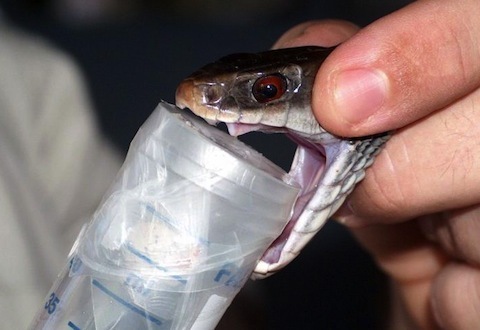
Nearly two years ago, I posted about the exorbitant prices of anti-venom, which seem largely due to the reluctance of pharmaceutical manufacturers to service such a relatively small market. The end result of those companies' economic sensibility is a dearth of medication in Papua New Guinea, where snake bites are a serious public-health problem:
In Central Province (which surrounds the national capital, Port Moresby), the incidence averages 215.5 victims per 100,000 people, but in some sub-provinces, such as Kairuku (which includes Yule Island and the villages of Bereina and Veifa'a) localized incidence exceeds 1,300 victims per 100,000 – among the highest rates of snake bite in the world. Each year in Central Province an average of 7.9 victims per 100,000 die as a result of snakebites, and this figure may in fact be far higher – many victims die before they can reach Aid Posts and Rural Health Centres, and these deaths rarely register in official statistics.
The good folks over at the Australian Venom Research Unit have been working on this problem for over a decade now. Their goal is to design an anti-venom that can be produced locally in Papua New Guinea, for a price (around $100 per dose) that is not totally prohibitive. They're finally getting somewhat close to making that happen, having finally received a sizable grant to conduct a clinical trial. If thing pan out like we'd all hope, the new, cut-rate anti-venom will be the first drug of its kind to emerge in fifty years.
The awesome secret to the discount formula? Horse plasma.
More of Microkhan's surprisingly extensive anti-venom coverage here.
October 24, 2011
Goals and Problems
Last day to take advantage of a sweet childcare situation. Trying to churn out a good thousand words worth of book between now and 5 p.m.—four thousand words less than Sinclair Lewis produced during his eight-hour writing stretches, but we can't all be geniuses. Back soon with the delectable stuff; in the meantime, I once again urge you most strongly to give Fresh Produce a listen.
October 21, 2011
By Accident of Birth
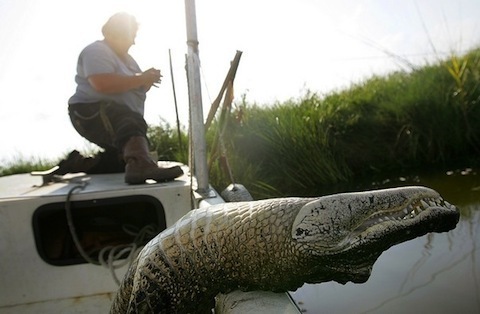
I am sure that hunting alligators on the Bayou is an especially tricky way to make one's living. But according to this profile of a lady far tougher than I'll ever be, the vocation is at least somewhat easier if you have the good fortune to belong to a favored family:
Victoria Bouvier, a 41-year-old mother of two from Mathews, has been alligator hunting for the past 10 years and loves it. Growing up, Bouvier was a tomboy: riding horses, hunting ducks, tinkering with cars — all the things her two brothers did. But she only began hunting alligators when she met her husband, Alexie Serigny, a decade ago.
Serigny was grandfathered into the alligator-hunting business, which means he doesn't have to participate in the yearly lottery for alligator tags. He inherited about 1,000 acres to hunt in an area protected by the Louisiana Department of Wildlife and Fisheries near Cut Off.
The closed-shop nature of Louisiana's alligator-hunting system isn't exactly making folks millionaires, though—the profile states that basic gators go for as little as five dollars per foot on the open market.
October 20, 2011
Plateau Bargaining
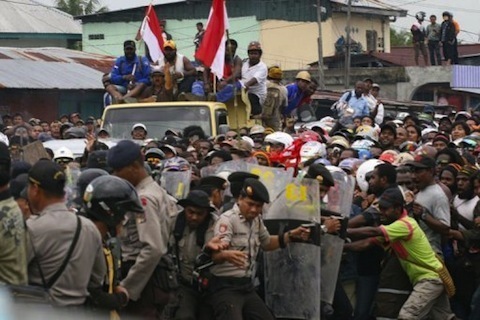
The world economy isn't only roiled by the machinations of Wall Streeters who are too clever by half; old-fashioned strikes can still upset the delicate equilibrium between prosperity and chaos. An excellent case in point is the ongoing fracas at the Freeport's Grasberg mine in the restive Indonesian province of Papua. The operation is the third-largest copper mine in the entire world, and accounts for nearly two percent of Indonesia's total GDP. As explained in this excellent rundown, the workers there have enjoyed little reward for their labor over the years, as most of the proceeds have been siphoned off by corrupt officials in distant Jakarta. That said, the striking workers certainly weren't shy about opening the negotiations with a wage demand that can charitably be described as leaning toward the astronomical side:
Freeport Indonesia union has said it could lower its pay demand to $7.50 an hour, from a previous demand for at least $12.50 and initial calls of as much as $200 an hour. Current pay is $1.50 to $3.00 an hour.
I would love to know how the union's representatives calculated that initial wage demand. Perhaps recompense for the billions that have ended up in politicians' pockets over the years?
(Image via AFP)
October 19, 2011
Taking Advantage
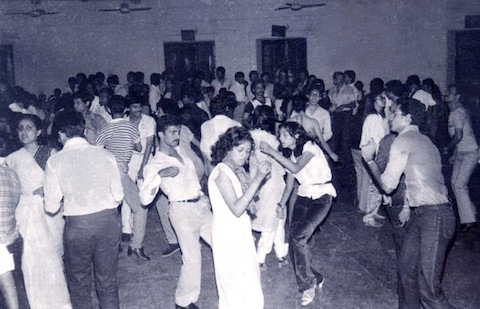
Apologies for not keeping up with Microkhan like I should these past few days. Just too wrapped up trying to make progress on the book, which is coming along in fits and starts that occur all-too-rarely. I'm now challenging myself to have 25,000 words done before Halloween; otherwise, I fear that too many nights of waking up in cold sweats lie ahead.
Not abandoning this project by any means—certainly not!—but posts may be a bit shorter than usual over the next few days. Today, for example, I'm just going to punt to the awesome Indian Memory Project, gracious provider of the seventies-era dance party photo above.
The good news is that my writing process is producing a cornucopia of extras that will fill many, many months of Microkhan. Stay tuned.
October 18, 2011
The Sobotkas of Lagos
[image error]
Advocates for limited government appear to have a new icon in Dr. Ngozi Okonjo-Iweala, Nigeria's finance minister, who appears to subscribe to Ronald Reagan's fabled view on the public sector. Just check out what she's doing at Nigeria's ports, where an alphabet soup of government agencies have been fleecing importers and exporters alike for ages:
The Federal Government through the finance minister and leader of the economic management team, Dr. Ngozi Okonjo-Iweala last week slashed agencies at the ports to half retaining only critical agencies that would have permanent stay at the ports. She also announced the disbandment of the Customs taskforce and directed Customs to begin a 24-hour shift operation…
The agencies issued a two-week ultimatum to vacate the ports included the National Agency for Food Drug Administration and Control (NAFDAC), Federal Environmental Protection Agency (FEPA), Directorate of Naval Intelligence (DNI), National Drug Law Enforcement Agency (NDLEA) and the Plant Quarantine and Animal Quarantine (PQAQ). Others are National Environmental Regulatory and Standards Agency (NESREA), and the Standards Organisation of Nigeria (SON), the Economic and Financial Crimes Commission, (EFCC), Independent Corrupt Practices and other Related Offences Commission (ICPC), among others. Although the finance minister said there were 14 agencies at the port, most stakeholders put the number at over 20…
The reforms, the minister said were targeted at reducing cost of doing business at the seaports, which experts believe is among the highest in the world.
Corruption is nothing new to the world of maritime trade, as anyone familiar with On the Waterfront can attest. But it's interesting that Nigeria's problem totally inverts that which plagued the U.S. a couple of generations ago; their racketeers are government employees, rather than mafiosi.
October 17, 2011
Play with Your Emotions
On a Wired deadline today, so just offering a taste of what's to come this week—a tangential bit of art peeled off from a newly developed interest in the Torres Strait Islands independence movement. I was hoping to track down an example of the baizam, or shark dance, which features the most awesome headdresses you've ever seen. But I had to settle for the above clip of the kab kar, a dance commonly classified as "old fashioned" by those in the know. But the classics never get old, now, do they?
October 14, 2011
Everything Counts in Large Amounts
Buried in this alarming account of crooked Brooklyn cops is a brief aside about how New York City is settling up with the scandal's victims. Dozens, if not hundreds of men were falsely imprisoned after having drugs planted on them by police striving to hit their monthly arrest quotas. How much money do those men deserve? The city has a fairly specific dollar amount in mind:
To settle civil actions, the city is paying about $1,000 per hour of wrongful incarceration, said Richard Cardinale, a lawyer in Brooklyn who said he had filed claims for 25 people and received settlements for all of them.
The story offers no explanation as to how that thousand-dollar-an-hour figure was arrived at, which is a shame—the actuarial wizardry that goes into ascribing monetary value to intangible concepts like freedom is truly fascinating. As much as we like to spout platitudes about how life is priceless, the fact of the matter is that when push comes to shove, we're often forced to put price tags on the most precious gifts of all. And given that our species is pretty adamant in the belief that mathematical formulas can accomplish anything, we've actually put a great deal of thought into figuring out the "right" sum to award those who've lost an incalculable amount.
I covered this terrain several years back for Legal Affairs, in a piece looking at the formulas that courts use to calculate "hedonic damages"—that is, money to compensate for the loss of happiness. Economists have concocted some pretty ingenious ways to price out such an abstract concept:
AT THE HEART OF SMITH'S FORMULA is a concept called "willingness to pay," or WTP. This can be broken down into two subsets, the "wage-risk model" and the "consumer expenditure approach." The former analyzes how much additional salary people demand to assume additional risk. Suppose you're a security guard and your boss wants to transfer you to a downtown warehouse where the crime rates are higher. In the new neighborhood, your odds of being killed in the line of duty will double from 1 per 2,000 to 1 per 1,000. Aware of this danger, you ask for a pay raise of $3,000 a year. So, according to Smith's calculations, you've just valued your life at $3,000,000—$3,000 multiplied by 1,000. Not that Smith tailors his formula to the particulars of an individual's life; rather, he examines decisions in numerous professions and comes up with a range of averages.
The consumer expenditure approach looks at how much people are willing to spend on safety products to reduce their risk of death. Let's say you've splashed out $1,000 for a snazzy burglar alarm, which has lessened your risk of being shot by a robber by 0.02 percent; then, you've valued your life at $5,000,000.
For some reason, this whole line of inquiry always makes me think of a classic The Simpsons quote, uttered by Bart upon being told that he has found an artifact (an alternate ending to Casablanca) that could be "priceless." "Priceless like a mother's love?" he asks. "Or the good kind of priceless?"
October 13, 2011
The Roots of the Infographic
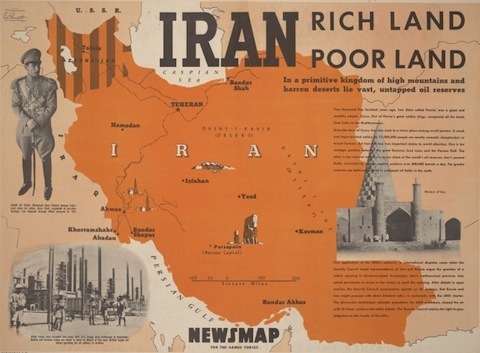
I'm almost ashamed to admit how much time I've wasted over the past few days sifting through this nifty archive of World War II "newsmaps," which were essentially weekly progress updates published by the Army's Special Service Division. Though tinged with the air of propaganda—it's not like they ever reported on setbacks, and the enemy was crudely stereotyped—the newsmaps were several degrees more sophisticated and informative than your typical wall poster. Especially as the war drew to a close, the newsmaps' creators tried to educate Americans about the geopolitical challenges that lay ahead. Granted, their efforts may seem a bit facile in hindsight (see above), but they deserve plaudits for pioneering the integration of meaningful text with beautiful artwork. Their shoulders are what today's infographic masters stand upon.
Highly recommend that you take a few moments today to check out the whole collection, which is hosted by the University of North Texas. The issue that details the planned assault of Japan that never happened is a personal favorite.




